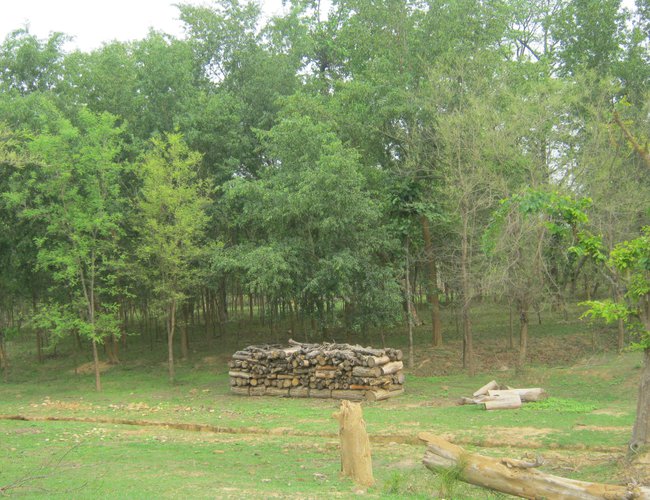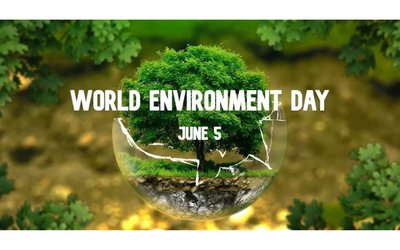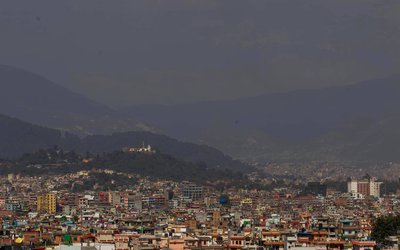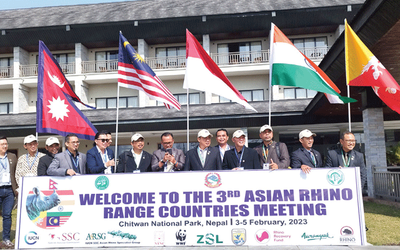
When tackling climate change and accelerating low carbon development in Nepal has been our top priority for some time now, we cannot let any of our actions fail and starve adaptation action on its very foundation. When there is not much in our historical records to show how environmental and climate adversities were dealt centuries ago, there is a common consensus that we did not have this issue as worse as now in the known history of the country. This is primarily because, for ages, we have had a limited population, demanding much less from the nature, and that too with diverse ecosystem and equally diverse culture and traditions offering inherent solutions in the form of indigenous ecological knowledge and socio-cultural practices such as the barter system filling up the production and distribution gaps. However, this perfection was never meant to persist indefinitely. Thus, as the time passed by, the population increased, so did our greed. Forests degraded and forest coverage declined, water resources became scarce and contaminated, fertile soil continued eroding, atmosphere got loaded with more dose of anthropogenic pollution, urban centres turned to “hot pans “and wild lives continued disappearing at the cost of our desperateness for modernization, development and a lavish life style. When there is nothing bad wants to be modern and live a better life, our unsustainable and undesirable approach to gradually transit from “what we were” to “what we are” and “what we are dreaming to be”, created a lot of problem. The magnitude of this problem was worse, as this was a global trend, and people from other parts of the world that we refer as early industrialized nations seemed to have over-smarted and overtaken us, not only in developing their countries first, but also in ruining the world first. By nature, we human are selfish beings, who “taketh more than giveth back”. However, that selfishness needs some wisdom attached to it as we prepare to tackle the issues like climate change and poverty. We need to accept that modernization doesn’t sustain at the cost of ruining natural capital, destroying social capital, and just by riding the back of not-so-thriving financial capital, when the government institutions are far more weaker than any time before, policy corruption is at its peak, and most actors - from ordinary citizen to bureaucracy and political leadership, all are trying to reap the benefits without caring about it’s implications (someone else’s loss).
When the least developed countries like Nepal are battling against climate change, it is obvious that the focus will be placed on adaptation and mitigation seen as secondary. When the climate change terminologies used by a specific group of people (experts) may leave the ordinary people puzzled most of the time, it is responsibility of all of us to demystify this “secret science” by communicating in simpler languages that can be understood by the majority of the population – “science for society”, especially when the issues is as basic as adaptation. Climate crisis deserves more attention than plain jargon. Let us accept the fact – “adaptation is never a new thing-in-making”. Humans have been practicing socio-economic and ecological adaptations to environmental adversities and variabilities, including climate change, for ages through development of suitable practices (such as early examples of irrigation, insurance and weather forecasting), cultures, and technologies, enabling them to enhance local environmental conditions and living. Even in the academic circle, the discussion on adaptation has received attention as early as 1970s, first within the Club of Rome, then within cold-war time institution International Institute for Applied Systems Analysis (IIASA) following publication of C. S. Holling’s Adaptive Environmental Assessment and Management in 1978, and later within the IPCC debates, until now. When the discussion about mitigation and adaptation as the most effective responses to climate change is omnipresent in the scientific community since then, as E. Lisa F. Schipper nicely summarises, our historical focus on adaptation has been on individual and ecosystem adaptation in response to growing understanding about transforming nature-based systems, that, at one point, could breach the non-reversible ecological threshold. The adaptation issues have received more attention mainly after 1990s, thanks to some deliberate efforts to categorically differentiate them. You may blame them as academic politics or appreciate as more organised efforts to understand them individually and in-connection, but the fact is, this eventually helped to get the adaptation process formally recognised and acted upon within the United Nations Framework Convention on Climate Change (UNFCCC) mechanism. This also aided in establishing view mitigation and adaptation need different thinking, approach and policy as well as scientific fora to develop more and be more effective. This change at the UNFCCC level, eventually opened door for current form of adaptation finance and transformed adaptation actions into something big in quick succession, despite the global economic setback started in 2007/08. With this flow, Nepal too hugely benefitted as everything we see now presented as adaptation in Nepal have happened in last two decades, such as Nepal National Adaptation Programme of Action (NAPA), Local Adaptation Plan of Action (LAPA), National Climate Policy, Nepal-Pilot Program for Climate Resilience (PPCR), Nepal Climate Change Support Programme (NCCSP) and work-in-progress National Adaptation Plan (NAP) to name a few. However, this separation between adaptation and mitigation also started creating a gulf of understanding between two communities working on these now “differentiated topics” and has partly contributed to their ideological crisis. As a result, climate solutions somehow, suddenly, started appearing as “segregated efforts” from what they should be – “integrated efforts”. And now, it has gone too far, esp. when we see some so called experts, unhesitatingly claiming adaptation is for least developed and developing countries whereas the mitigation is exclusive responsibility of the developed countries, or say those who industrialised first, polluted the environment first, and are now are part of the Organisation for Economic Co-operation and Development (OECD).
This was the turning point; we started wrong approach –a rather fragmented approach, to solve the "Planetary Catastrophe" that does not leave a single aspect of our life unharmed. Wisdom says, adaptation is a package deal for our very survival in the changing climate and comprises of efforts related to “struggle” and “cooperation” combined, a shift from Darwin’s early concept of “struggle for existence”. In addition, if it is so, how can we continue separating mitigation from adaptation and still expect to develop a complete solution? Doesn’t this seem like, the legendary Kalidas cutting the branch of a tree on which he was sitting? What kind of solutions are we expecting out of it?
Given this and also considering prevailing geo-political chaos, socio-economic divide, ecological crisis, religio-cultural conflicts we are living with, and how global approaches to solve this crisis are changing, we need to recognise and embrace the following, in our plans and of course, actions:
- It’s not about adaptation or mitigation, it is about combined efforts: It is very often disappointing to see perennial "adaptation-mantra" from the government and the development agencies as the only solution to the climate crisis in Nepal, as if, talking about mitigation actions are dispensable, and sometimes, even a crime. Three key disciplines of climate science – scientific research, mitigation measures, and adaptation efforts are just like bone, flesh and blood in our body. Separate one, and rest everything else is incomplete. We must get away from rhetoric and be more pragmatic. After all, tackling climate change is not a mere project; it is a mission to secure very survival of the people. This is even more important considering changing politics of climate finance at global level, increased role of private sector, including the multilateral development bank, and their growing attractiveness in mitigation related projects. Nepal’s Intended Nationally Determined Contributions (INDC), could actually be a very good marketplace to start with.
- It’s not about excessive freedom and isolated missions impossible, it’s about a concerted effort with a clear rule-book that works: Tackling climate change, be it mitigation, adaptation or understanding the scientific basis, is not a sole responsibility of the state or any other individual actor in the country. When we may unhesitantly wait for some state actions to come and hope them to succeed, we all have our parts to play by investing in our present and future even before the government comes in. We can’t just hold back our greed and develop the culture of constant complaining. When the government efforts can help develop long-term solutions to climate change at much larger scale, it is not in the very nature of the climate adversities to wait for the government to make a move first. Just because the government does not put solutions on time, or does a poor job of doing so(as it is evidently inefficient most of the time), the floods will not stop, glaciers will not retreat, drought will not soften and farms will not yield more food. Therefore, the first investment has to come from people and spontaneously. Our gamble to wait for government actions will inadvertently crumble existing infrastructures and eventually shamble the whole system. This is where the role of social capital comes in. Rather than dissolving or limiting roles of institutions like “Guthis”, we actually need to increase their numbers and expand their scopes, including issues related to environment and climate change. Moreover, recent policy discussions on regulating non-governmental organizations (NGOs) working on climate issues does not have to be seen entirely negatively. We cannot ignore the number of the neo-elites that have born out of NGO business in last three decades, when the countries have failed miserably, in every aspect. We should not just take regulation needs as an oppressive state behaviour; rather this an opportunity needs to be utilised to refine the dirt and corruption within the non-government sector (of course, government too needs major cleaning work). Climate populism (for creating a trade-mill) is a massive danger to the very actions of climate change in the country as I have repeatedly argued before. There is a clear need of a social movement to prevent “climate projects” from becoming the “corruption projects”. This is why, we definitely need regulations, but more of that in the form of monitoring and evaluation, and not necessarily in limiting their access to finance and people. Let us all held everybody responsible, and join the force for a better cause.
- It’s just not about actors, It’s actually about climate governance: Power-sharing, accountability, fairness, transparency, realistic assurance, leadership and stakeholder engagement are key for every climate efforts. When a capable leadership, and all forms of fairness, transparency and accountability are always expected from the government (although it has always disappointed in our countries), realistic assurance and stakeholder engagement are two issues, I often find underachieved but always over-marketed. First thing first - The government agencies should be prudent and proactive enough in discreetly communicating, they do not have magic sticks to carry the environmental burden created by all of us, at once. When they have select plans in place and some actions on the ground, they should clearly communicate the true scope of the work. Misinformation, such as over-expectation and wrong expectations shown by them or any other actors, such as NGOs, should be treated as a crime. This is because, an effective preparedness to disaster is only possible, when locals know what is the scope of support they can expect from the government or the NGOs. When the lip-servicers or ill communicators give wrong assurances to the people, they will eventually end up with – “god bless you” as the only solution. Similarly, we need more clarity in terms of power sharing between different actors in the society and within the government, at different scales, and now considering the complexities the concept of federalism brings in.
- And, It’s mostly about which sector can play the most important role and deliver better economic returns: As long as people keep converting forests and agriculture lands to urban centres, abandoning agriculture and live unsustainably leading to an absolute import-oriented economy, there is nothing even the smartest of the governments can achieve. Here we need a clear assessment of our realities - resources and needs. As time has presented the concept of green economy as one of the most convenient options ahead, some of us have recently done much needed assessment in this area and have presented a roadmap for “public–private partnership-driven full-fledged green economy” focusing on renewable energy and transport, agriculture and forestry, water and water-induced disasters, as well as tourism and hospitality.
For detailed analysis, please read the articles below, The first article appears in an open access journal, whereas the second can be shared for non-profit purposes (mail: tekjungmahat.at.gmail.com).
Climate finance and green growth: Option analysis for Nepal:
Mahat, Tek Jung, LuděkBláha, BatuUprety, and Michal Bittner. "Climate finance and green growth: reconsidering climate-related institutions, investments, and priorities in Nepal." Environmental Sciences Europe 31, no. 1 (2019): 46.
Framing green economy in mountainous countries like Nepal:
Rueff, H., Kohler, T., Mahat, T. J., &Ariza, C. (2015). Can the green economy enhance sustainable mountain development? The potential role of awareness building. Environmental science & policy, 49, 85-94.

















